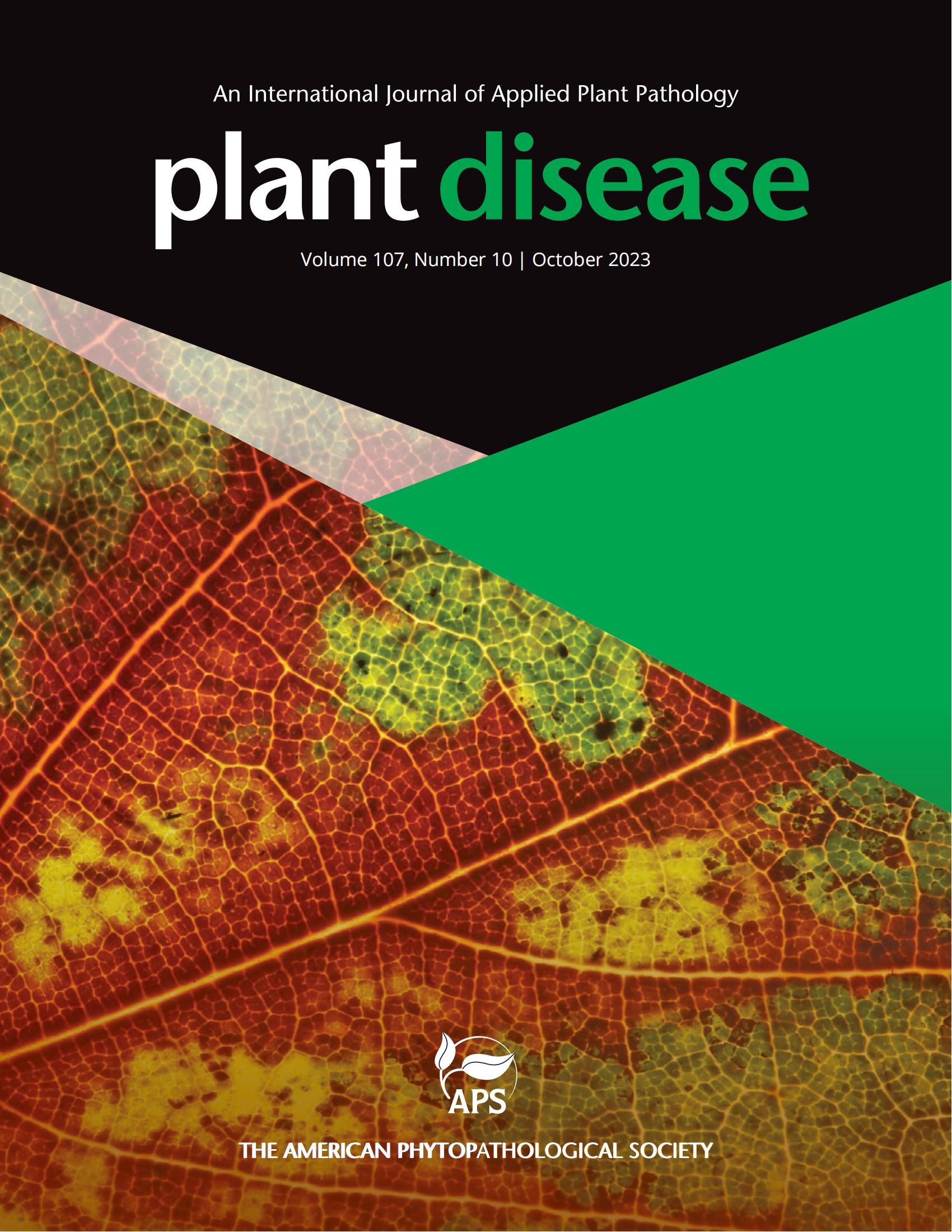中国西伯利亚百合(Lilium spp.)观赏杂交种基腐病研究初报。
摘要
百合“西伯利亚”,在中国广泛种植,具有很高的经济价值,因为它是一种受欢迎的观赏百合。2023年8月,在辽宁省农科院综合温室(面积约2000 m2),约60%的2年生植株发生百合基腐病。最初的症状出现在鳞茎底部,随着时间的推移,鳞茎底部出现棕色病变,后来叶子变黄,大约一个月后,整株植物死亡。为分离病原菌,从5株有症状的基腐病植株中采集组织,用75%乙醇溶液对感染的鳞茎进行表面消毒30 s,然后进行三次无菌水洗,无菌干燥后分离病原菌。表面灭菌后,将5 mm × 5 mm的组织切片从植物病变边缘转移到马铃薯葡萄糖琼脂(PDA)培养基上。培养物在25℃下保存以分离病原体。7 d后,在单孢子分离株的基础上,制备了3株表面形态一致的菌株(H1、H2和H3)。10到15天后,菌丝完全覆盖了培养皿。菌丝分枝,分离,光滑,透明,分生孢子黑色,单生,球形或近球形,有光泽,大小为8.3 ~ 11.4 μm × 12.4 ~ 14.9 μm (n=50),产生于透明状和瓶形分生孢子的尖端。该真菌与黑孢菌(Nigrospora oryzae)具有相似的形态特征(Wang et al. 2017)。为了从分子上确认物种的身份,采用CTAB法提取了3株分离株(H1、H2和H3)的基因组DNA (O'Donnell et al., 1998),并利用引物ITS1/ITS4、EF1-728F/EF-2和Bt-2a/Bt-2b分别对核糖体RNA的内部转录间隔区(ITS)、翻译伸长因子亚基1- α (TEF1- α)和β -微管蛋白(TUB2)基因进行了部分PCR扩增(Wang et al. 2017)。BLASTn分析显示,分离株(H1、H2和H3)的核苷酸序列一致性为99%(500/501bp;488/488的英国石油(bp);ITS为495/499bp), TEF1- β为461/461 bp, 466/467 bp, 467/467 bp;99% (331/333 bp;376/384的英国石油(bp);381/388 bp)的TUB2序列,GenBank中有N. oryzae LC2702。结果序列提交给GenBank,其登录号为PP203296, PP784618, PP784619,用于ITS;PP417827, PP869279, PP886084,用于TEF1-;分离株H1、H2和H3的TUB2基因分别为PP448183、PP869277、PP869278。邻近连接的系统发育树显示,这3个西伯利亚百合分离株属于n.o oryzae分支。因此,基于形态学和分子证据,分离物H1、H2和H3被鉴定为N. oryzae。一个代表性的分离物(H1)被用来完成科赫假设。对1年生的健康西伯利亚百合球茎进行致病性试验,对球茎进行消毒,用无菌针扎球茎基部,然后种植在消毒过的土壤中。采用分生孢子悬浮液(1 × 106个/ml)每5天浇灌一次,对照组用无菌水浇灌。每个处理包含30个球茎,实验重复3次。在25℃下接种15 d后,接种H1的鳞茎开始变黑腐烂,鳞茎周围可见黑色。对照植株未发病,未检出病原菌。通过形态学特征和ITS序列(PQ686265)鉴定该真菌为黑孢菌。根据Koch’s hypothesis,水稻黑孢菌是百合基底腐病的病原菌。据我们所知,这是中国首次报道由水稻黑孢菌引起的西伯利亚百合基底腐病。Lilium 'Siberia', is extensively cultivated and has high economical value in China due to its popularity as an ornamental lily. In August 2023, lily basal rot was observed on about 60% of two-year-old plants at the Liaoning Academy of Agricultural Sciences Multiplex greenhouse ( in an area of about 2000 m2 ) . Initial symptoms appeared on the base of the bulbs as brown lesions that expanded over time, and later the leaves turned yellow and about one month latter the whole plant died. To isolate the causal pathogen, tissues were collected from 5 symptomatic plants with basal rot. The infected bulbs were surface-sterilized with 75 % ethanol solution for 30 s after initial rinsing, followed by triple sterile-water washes, specimens were dried aseptically prior to pathogen isolation. Tissue sections 5 mm × 5 mm were transferred from plant lesion margins onto potato dextrose agar (PDA) medium after surface sterilization. Cultures were maintained at 25℃ for pathogen isolation. After 7 days, 3 consistent surface morphology strains(H1, H2 and H3) were prepared based on single spore isolates. After 10 to 15 days, mycelium had fully covered the plates. The hyphae were branched, septate, smooth, hyaline, Conidia were black, solitary, globose or subglobose, glossy aseptate of 8.3 - 11.4 μm × 12.4 - 14.9 μm (n=50) in size, and produced at the tips of hyaline and ampulliform conidiophores. The fungus showed similar morphological characteristics to Nigrospora oryzae (Wang et al. 2017). For molecular confirmation of the species identity, genomic DNA of three isolates (H1, H2 and H3) were extracted by the CTAB method (O'Donnell et al., 1998), and portions of three genes, the Intemal Transcribed Spacer (ITS) of the ribosomal RNA, the Translation Elongation Factor subunit 1-alpha (TEF1-ɑ) and the beta-tubulin (TUB2) genes were amplified by the PCR using the primers ITS1/ITS4,EF1-728F/EF-2 and Bt-2a/Bt-2b (Wang et al. 2017). A BLASTn analysis showed that the identity of the nucleotide sequences of isolates (H1, H2 and H3) were 99%(500/501bp; 488/488 bp; 495/499bp) for ITS, 99% (461/461 bp;466/467 bp;467/467 bp) for TEF1- ɑ; and 99% (331/333 bp; 376/384 bp; 381/388 bp) for the TUB2 sequences, with N. oryzae LC2702 in GenBank. The resulting sequences were submitted to GenBank under accession numbers PP203296, PP784618, PP784619 for ITS; PP417827, PP869279, PP886084, for TEF1-ɑ; PP448183, PP869277, PP869278 for TUB2 of isolates H1, H2 and H3 respectively. A neighbor-joining phylogenetic tree showed that the three isolates from Siberian lily clustered with the N.oryzae clade.Therefore, the isolates H1, H2 and H3 were identified as N. oryzae based on morphology and molecular evidence. One representative isolate(H1) was used for completing the Koch's postulates. A pathogenicity test was made on 1-year-old healthy Siberia lily bulbs, the bulbs were disinfected, using a sterile needle to prick the base of the bulbs, then they were planted in sterilized soil. A conidial suspension (1 × 106 conidia/ml) was used to water the planted lily bulbs once every 5 days, and the controls were watered with sterile water. Each treatment contained 30 bulbs, and experiment was repeated three times. After 15 days of inoculation at 25℃, the bulbs inoculated with H1 began to turn black and to rot, and black perithecia were visible. The control plants did not show disease and no pathogen was isolated from them. We reisolated the pathogen from infected tissues, after observation of the morphological characteristics and ITS sequence ( PQ686265 ) the reisolated fungus was identified as Nigrospora oryzae. According to Koch's Postulates, Nigrospora oryza was the pathogen causing lily basal rot. To our knowledge, this is the first report of basal rot on Lilium'Siberia'(Lilium spp.) caused by Nigrospora oryzae in China.

 求助内容:
求助内容: 应助结果提醒方式:
应助结果提醒方式:


